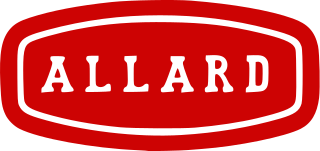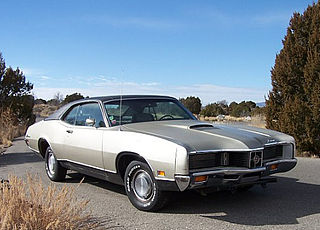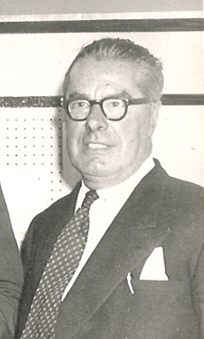
Cosworth is a British automotive engineering company founded in London in 1958, specialising in high-performance internal combustion engines, powertrain, and electronics for automobile racing (motorsport) and mainstream automotive industries. Cosworth is based in Northampton England, with facilities in Cottenham England, Silverstone England, and Indianapolis IN US.

Allard Motor Company Limited was a London-based low-volume car manufacturer founded in 1945 by Sydney Allard in small premises in Clapham, south-west London. Car manufacture almost ceased within a decade. It produced approximately 1900 cars before it became insolvent and ceased trading in 1958. Before the war, Allard supplied some replicas of a Bugatti-tailed special of his own design from Adlards Motors in Putney.

The VK engine is a V8 piston engine from Nissan. It is an aluminum DOHC 4-valve design.

Delage was a French luxury automobile and racecar company founded in 1905 by Louis Delâge in Levallois-Perret near Paris; it was acquired by Delahaye in 1935 and ceased operation in 1953.

Ferrari America is a series of top-end Ferrari models built in the 1950s and 1960s. They were large grand touring cars with the largest V12 engines and often had custom bodywork. All America models used a live axle in the rear, were front-engined, and had worm and sector steering.
Eric Brandon was a motor racing driver and businessman. He was closely associated with the Cooper Car Company, and was instrumental in the early development of the company.

The Austin Motor Company A series is a small straight-4 automobile engine. Launched in 1951 with the Austin A30, production lasted until 2000 in the Mini. It used a cast-iron block and cylinder head, and a steel crankshaft with 3 main bearings. The camshaft ran in the cylinder block, driven by a single-row chain for most applications, and with tappets sliding in the block, accessible through pressed steel side covers for most applications, and with overhead valves operated through rockers. The cylinder blocks are not interchangeable between versions intended for conventional end-on mounted gearboxes and the 'in-sump' transaxle used on BMC/BL front wheel drive models such as the Mini. The cylinder head for the overhead-valve version of the A-series engine was designed by Harry Weslake – a cylinder head specialist famed for his involvement in SS (Jaguar) engines and several F1-title winning engines. Although a "clean sheet" design, the A series owed much to established Austin engine design practise, resembling in general design and overall appearance a scaled-down version of the 1200cc overhead-valve engine first seen in the Austin A40 Devon which would form the basis of the later B-series engine.

JA Prestwich Industries, was a British engineering equipment manufacturing company named after founder John Alfred Prestwich, which was formed in 1951 by the amalgamation of J.A.Prestwich and Company Limited and Pencils Ltd.
HRD Motors Ltd was a British motorcycle manufacturer in the 1920s. It was founded by Howard Raymond Davies. He had worked in motorcycling, and had raced with some success in the mid-twenties, but often not finishing due to unreliability. This inspired him to build a reliable performance motorcycle, using the advertising slogan "Built by a rider". Others also aimed at a similar market, like George Brough of Brough Superior motorcycles.

The Mercury Cyclone is an automobile that was marketed by the Mercury division of Ford from 1964 to 1971. Introduced in 1964 as the Mercury Comet Cyclone, the Cyclone replaced the S-22 as the performance-oriented version of the Mercury Comet model line. The Cyclone became a distinct nameplate for the 1968 model year, as the Mercury Montego was phased in to replace the Comet.

Lorraine-Dietrich was a French automobile and aircraft engine manufacturer from 1896 until 1935, created when railway locomotive manufacturer Société Lorraine des Anciens Etablissements de Dietrich et Cie de Lunéville branched into the manufacture of automobiles. The Franco-Prussian War divided the company's manufacturing capacity, one plant in Niederbronn-les-Bains, Alsace, the other in Lunéville, Lorraine.

The Cooper Mark IV was a Formula Three, Formula Two and Formula One racing car designed and built by the Cooper Car Company at Surbiton, Surrey, England, in 1950.

Charles Newton "Charlie" Cooper was a British motorsport mechanic, designer and entrepreneur.
The Cooper Mk.V, is a series of three different Formula 3 cars, designed, developed and built by Cooper Cars in 1951. Like its predecessor, it used a 500 cc (31 cu in) JA Prestwich Industries (JAP) single-cylinder engine, or a 1,000–1,100 cc (61–67 cu in) JA Prestwich Industries (JAP) V-2 engine. The first version was the short-wheelbase Cooper T15; which featured a box-section chassis frame, detachable body panels, and a rack-and-pinion steering system. The second version was the long wheelbase Cooper T16, which featured a lengthened wheelbase to be able to equip the larger 1 L (61 cu in) engine. And the third and final version, the Cooper T17; which was a special streamliner version land speed record attempt car for speed record attempts, and sometimes, used for fast road racing circuits.

The Cooper Mk.VIII is a Formula 3 car built by British manufacturer Cooper Cars in 1954. It came in three different versions. The first was the Cooper T31; which featured a curved tubular chassis, a revised transmission housing, a central scuttle tank, a "curled-leaf" spring, and a 500 cc (31 cu in) JA Prestwich Industries (JAP) single-cylinder engine. The second version was the Cooper T32; which featured an elongated chassis and body, and a larger and more powerful 1,100 cc (67 cu in) OHV V-2 engine. The third and final iteration was the Cooper T28; which was a streamliner designed for setting speed records.

The Cooper 500, also referred to as the T2/T3 , was a prototype 500cc open-wheel racing car designed and built by the Cooper Car Company in Surbiton, Surrey, England, and was their first ever car. The first post-war prototypes were built in 1946, shortly after the end of the Second World War. Since materials were in short supply immediately after World War II, the prototypes were constructed by joining two old Fiat Topolino front-ends together. It was powered by a 45 hp (34 kW) 500 cc (31 cu in) JA Prestwich Industries (JAP) 4B Speedway single-cylinder motorcycle engine, which drives the rear wheels through a Triumph Speed Twin gearbox, via chain. It was succeeded by their first successful production car, the Mk.II, in 1948.

The Cooper Mark III is a Formula Three open-wheel racing car designed and developed by the Cooper Car Company in Surbiton, Surrey, England, and built in 1949. It was the successor to the Mk.II, and was offered in two versions. The first option was the T7 ; which was powered by a powered by a 40 hp (30 kW) 500 cc (31 cu in) JA Prestwich Industries (JAP) 4B Speedway single-cylinder OHV motorcycle engine. The second option was the T9 ; which featured a longer chassis, with an elongated wheelbase, and used a larger and more powerful 70 hp (52 kW) 1,000 cc (61 cu in) JA Prestwich Industries (JAP) V-twin motorcycle engine. For the first time ever, a ZF limited slip differential was also offered as an optional extra for customers.

The Cooper Mk.IX is an open-wheel Formula Three race car, designed, developed and built by British manufacturer Cooper in 1955. The first version, dubbed the T36, was powered by a 500 cc (31 cu in) JA Prestwich Industries (JAP) single-cylinder engine, and featured a singular brake disk at the rear of the car, flatter springs to mitigate ground clearance, altered and adjusted center spring mountings, and reworked engine mounts. The second version, dubbed the T37, featured an elongated chassis and body, and a larger and more powerful 1,000 cc (61 cu in) OHV V-2 engine. Chassis construction was a tubular space frame, and the body was made from aluminium. Overall weight was between 500–530 lb (230–240 kg). The wheelbase was 7 ft 3 in (2.21 m), the rear track was 3 ft 7 in (1.09 m), while the front track was 3 ft 9 in (1.14 m), overall height was 2 ft 7 in (0.79 m), and the overall width was 1 ft 11.5 in (0.597 m).
The Cooper Mk.X, and its evolutions, the Mk.XI, the Mk.XII, and the Mk.XIII, are open-wheel Formula Three race cars, designed, developed, and built by British manufacturer Cooper in 1956. It was virtually identical in design to the previous Mk.IX. The internal designation, dubbed the T42, was powered by a 500 cc (31 cu in) JA Prestwich Industries (JAP) single-cylinder engine, and featured a singular brake disk at the rear of the car, flatter springs to mitigate ground clearance, altered and adjusted center spring mountings, and reworked engine mounts. The second version featured an elongated chassis and body, and a larger and more powerful 1,000 cc (61 cu in) OHV V-2 engine. Weight and chassis dimensions were essentially identical to the previous model.
The Cooper T85 was an open-wheel formula racing car, designed, developed and built by British manufacturer Cooper, for Formula Three racing categories, in 1967. It was their 16th and final Formula 3 car. It was powered by a 998 cc (60.9 cu in) BMC four-cylinder engine, developing around 88 hp (66 kW) @ 7,750 rpm, and had a 12.5:1 compression ratio. Only two models were produced. It used inboard front suspension, and was very similar in design to its predecessor. It is known to have entered one race at Brands Hatch in 1967, being driven by Les Leston, but did not end up finish the race. A Ford-powered version of the car entered a second race at Montlhéry in 1968, also without any success.
















